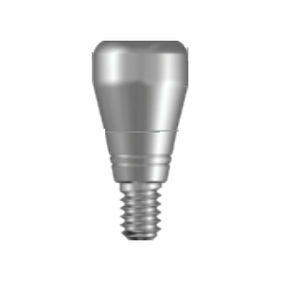
- Dental
- Dental practice
- Titanium implant abutment
- UFIT IMPLANT
Straight implant abutment MSA4xxx, SSA4xxx seriestitaniumhexagonalnarrow
Add to favorites
Compare this product
Characteristics
- Material
- titanium
- Connection
- hexagonal
- Configuration
- straight, narrow, screw
- Positioning
- submerged
- Implant diameter
Min.: 4 mm
(0.16 in)Max.: 6.5 mm
(0.26 in)
Description
Method
- Use solid abutment driver / 1.2 hex driver
- narrow 20Ncm joining Torque
- regular/wide/ultra-wide 25~30Ncm Joining Torque
Component
- solid abutment + Healing cap
Usage
- Used on the conventional cemet type produced prosthesis
- All-in-one abutment and screw structure
Conventional Abutment and sylbutment
The principles of
The principles of SYLBUTMENT are easily discovered around us.
In a conventional abutment, the gap between fixture and abutment may increase gradually due to repeated chewing forces. This is due to the contact between the outer surface
of the abutment and the inner taper of the fixture, which only occurs on a small surface
area due to the roughness of both the two surfaces. On the other hand, SYLBUTMENT
increases the contact surfaces by transformation to the grooves. It does not create a gap
as the transformation between the two surfaces occurs within the elastic range.
Why does loosening occur in conventional abutments?
The perfect contact of two at surfaces is only possible theoretically but practically impossible.
The perfect contact of two at surfaces is only possible
theoretically but practically impossible.
When a chewing force is applied then removed,
the gap between the two surfaces increase.
Catalogs
No catalogs are available for this product.
See all of UFIT IMPLANT‘s catalogsRelated Searches
- Implant abutment
- Titanium implant abutment
- Straight implant abutment
- Internal implant abutment
- Dental implant
- Titanium dental implant
- Hexagonal implant abutment
- Screw implant abutment
- Angulated implant abutment
- Tapered dental implant
- Dental implant analog
- Straight dental implant analog
- Gingiva former
- Hexagonal dental implant
- Impression cap
- Internal hexagon dental implant
- Titanium gingiva former
- Cemented implant abutment
- Narrow implant abutment
- Straight gingiva former
*Prices are pre-tax. They exclude delivery charges and customs duties and do not include additional charges for installation or activation options. Prices are indicative only and may vary by country, with changes to the cost of raw materials and exchange rates.




